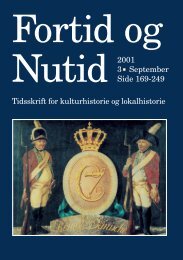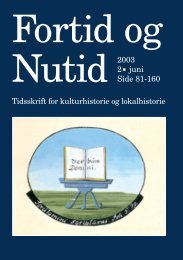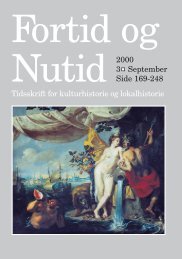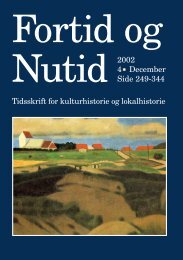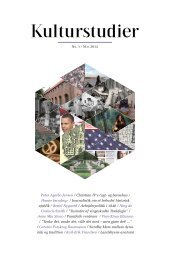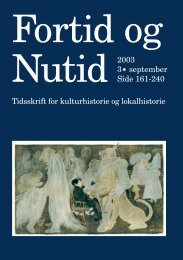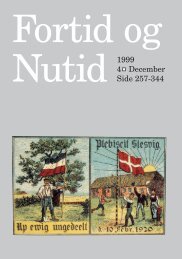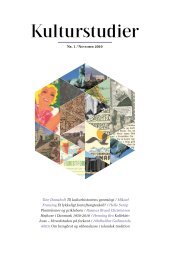Læs hele tidsskriftet (PDF) - Kulturstudier
Læs hele tidsskriftet (PDF) - Kulturstudier
Læs hele tidsskriftet (PDF) - Kulturstudier
You also want an ePaper? Increase the reach of your titles
YUMPU automatically turns print PDFs into web optimized ePapers that Google loves.
<strong>Kulturstudier</strong> Nr. 2, 2011 The reconfigured body 8/15<br />
and linear genealogy”. 22 The capitalization of transgenic and cloned pigs is a<br />
way of seeking new patterns for the use of the animal, and the biotechnology<br />
companies are striving against something that is not traditional dualism between<br />
what is a human body and what is an animal body. This form of capitalization<br />
recreates an old metaphor where pigs and other animals are seen as factory farms<br />
capable of producing cells, tissue and organs for people who are sick and in need<br />
of treatment. 23 The transgenic and the cloned pig are good examples of how the<br />
researchers saw this animal as a potential factory farm.<br />
After the first transgenic pig was born in 1992, David White succeeded in<br />
producing a second transgenic pig in 1995. This was highlighted in the Swedish<br />
tabloid Aftonbladet: “The pig is still a pig, it looks like a normal pig. It is only<br />
the pig’s organs that have become more human-like. The organs fit better in this<br />
way in the human body than they did before”. 24 A transgenic pig’s organs became<br />
more flexible and could now fit both pig and human. 25 Through the transformation<br />
of the pig’s cells, tissue and organs, they now became more like human cells,<br />
tissue and organs. The new technique initiated a change of equality between human<br />
and animal. This was somewhat opposed to the dehumanization of the pig,<br />
which has previously been discussed.<br />
At Lund University a research group planned transplantations of pig cells<br />
to patients with Parkinson’s disease. Clinical trials were never realized, but the<br />
research group conducted animal testing with immature pig cells transplanted<br />
into mice and rats, and they also experimented with transplantations from pig to<br />
pig. In the beginning, the embryos came from normal pig strains, but the research<br />
group had access to some of the transgenic pigs. The director of the research team<br />
pointed out in the interview: “The goal was to examine the feasibility of doing<br />
this with patients and to understand the mechanisms behind rejection, and to<br />
understand the biology. How the nerve cells fit, so to speak”. 26 Now, the dualism<br />
between the human and the animal body was being challenged on a cellular<br />
level, as the project focused on studying how different nerve cells are rejected<br />
and how they fit together. Human and pig cells were seen as something similar,<br />
and on a cellular level the human and the pig became more comparable. The medical<br />
researchers now looked for different technologies and methods to change<br />
the dualism between the different objects such as mice, rats, pigs and humans.<br />
Animal reproduction alone did not alter the relation between human and animal,<br />
but the different techniques and methods of using the animal were also vital for<br />
the reconfiguration of bodies. In order to succeed, the researchers needed to fit<br />
22 Twine 2010, p. 101.<br />
23 Fitzgerald 2003; Twine 2010.<br />
24 Aftonbladet 09.12.1995.<br />
25 Martin 1994.<br />
26 Interview: 20.10.2009.<br />
149



